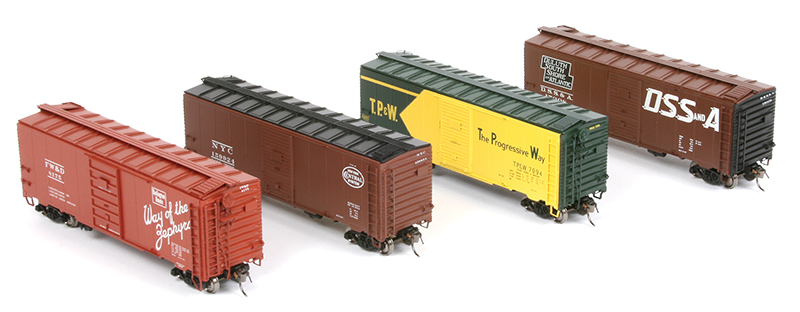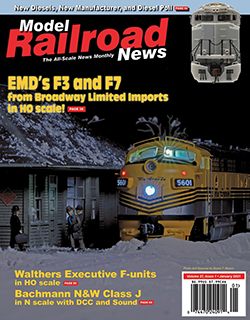 By David Otte
By David Otte
The Association of American Railroads (AAR) and its predecessor organizations have helped to bring efficiency, safety, and service to the railroad industry going as far back as 1892. Many AAR efforts have focused on the standardization of freight car construction and its recommended practices were adopted by most car builders and railroads both in the years preceding and following World War II.
No better example of this cooperation among industry members can be found than in the development of the American 50-ton boxcar design. Beginning in 1932, under the auspices of the American Railway Association (merged into the AAR in 1934), the organization’s “Committee on Car Construction” set the standard for the 40-foot steel boxcar, which would undergo a series of refinements over the next 15 years or so, and on which thousands of the ubiquitous house cars would be built.
As it was in real world, the hobby industry has likewise seen a number of AAR design boxcar renderings over the years with the model now before us coming from InterMountain Railway Co. As the latest reissue in its ready-to-run freight car series, the well-detailed 40-foot modified 1937 AAR Boxcar is affordably priced and currently available in a whopping 16 different colorful railroad paint schemes, each in six limited edition road numbers. Some of the paint schemes have never been offered before for this prototype, such as: Canadian Pacific (script scheme); Chicago & North Western (“Route of the Challengers” slogan); Duluth, South Shore & Atlantic; Erie Lackawanna; Erie (with large herald); Missouri-Illinois Railroad; Soo Line; and Toledo, Peoria & Western. The balance of the production run is comprised of rereleases with new road numbers: Canadian Pacific (newsprint service label); Fort Worth & Denver; Gulf, Mobile & Ohio; Missouri Pacific (“Route of the Eagles” slogan); New York Central; Rock Island; Southern Railway (with billboard lettering); and Union Pacific (“Road of the Streamliners” slogan).
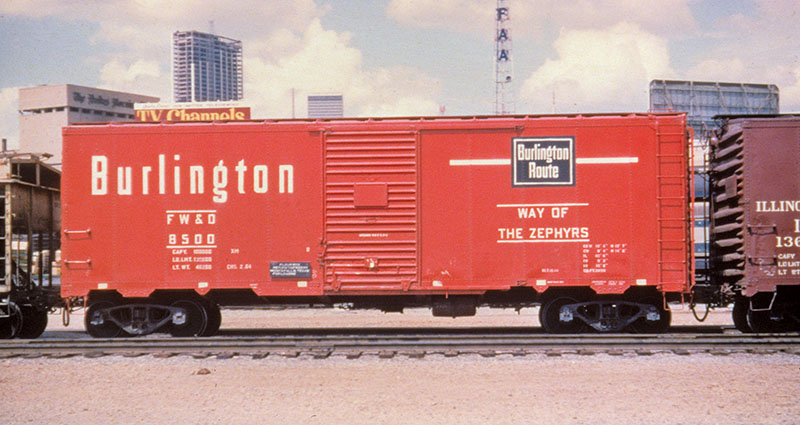
ABOVE: Fort Worth & Denver 8500 shows Burlington’s later Chinese Red livery. The car, rolling through Dallas, Texas, in the 1960s features a Youngstown-style sliding door, “XM” loading label denoting its general service applications, and data showing a 10-foot 6-inch interior height. As with the earlier scheme InterMountain Railway presents on its modified 1937 AAR boxcar, the slogans included differ on each side. This red car shows the “Way of the Zephyrs” slogan, while the opposite side of this car would have the “Everywhere West” slogan appearing on the HO model below and vice-versa. Burlington’s Fort Worth & Denver and Colorado & Southern subsidiaries utilized Chicago, Burlington & Quincy paint schemes for much of their equipment during this era. — Dick Kuelbs photo, Kevin EuDaly collection
The Prototype
As a direct descendent of the 1937 AAR boxcar, the modified 1937 AAR boxcar shares many attributes of the former design, which in turn would serve as a building block for the standard 40-foot car designs coming out of the postwar years, such as the 1944 (or “Postwar”) AAR boxcar and Pullman-Standard’s PS-1 series. Perhaps the most significant feature of the creation of the modified 1937 boxcar, however, is its interior height. Following a trend that began with the 1932 AAR design, railroads were bent on extending that car’s nominal nine-foot interior height in an effort to increase volume. The 1937 AAR established a new standard with a nominal interior height of 10 feet. Pushing the boundaries even further, the modified 1937 AAR boxcar, first introduced in late 1938, extended the interior height by as much as six additional inches. Regardless of the interior height, though, the 1932 and both 1937 and modified 1937 AAR designs continued to share a truck center spacing of 30 feet 8-1/2 inches and similar underframe structure.
Furthermore, the modified 1937 design used a Dreadnaught end formed of two panels, each displaying 5 ribs (abbreviated as a 5/5 end). This arrangement contrasts with the 1937 AAR car with its 4/5 Dreadnaught end; the extra rib on the later design no doubt aided in stiffening the ends for the extra height. While the ribs generally extended out to the width of the car end on the modified design, there are documented instances where the space above the top rib appeared shortened. This variation was dependent on what appears to be an optional interior height as some cars were built with a 10-foot 4-inch inside height, and thus have the shortened top course; those with a full 10-foot 6-inch height have the extended space above the top rib (this includes a few examples with 10-foot 5-inch height). In addition, two different corner-post designs are apparent with some earlier built cars (1939–1941) often constructed with square corners and cars erected starting after 1940, comprising the vast majority of modified 1937 AAR boxcars, constructed with W-section corners. Along with the two different inside heights and corner posts, the most common characteristics of the modified 1937 AAR boxcars included: 10-panel, riveted sides with 6-foot door openings; Murphy rectangular panel roof; tabbed side sills; poling pockets; and a 3,837- to 3,900-cubic-foot nominal capacity. Of course, with 44,315 of these cars built for U.S. roads through early 1946, there was bound to be some leeway in these attributes and the list is somewhat extensive.
Variations in the design included: 8-foot door openings; use of Viking-made roof; modified tabs on the side sills; different styles of Youngstown and Superior steel doors; either seven- or eight-rung side/end ladders; a variety of running boards (mostly wood, but steel on some lots) and hand brakes; the layout of the brake equipment beneath the car could differ between roads; and, the cars could ride on a variety of trucks with A-3 “Ride Control” trucks the most popular. Bottom line, the HO modeler will definitely need to consult photographs and railroad diagrams to confirm the appearance of the particular car they wish to model.
Last but not least, it is interesting to note that most of the railroads utilizing the modified 1937 AAR boxcar were either based in the Midwest or assigned their cars to service out of Chicago, where the excess height would not interfere with tunnel restrictions, which were prevalent in the East. It’s no surprise then that Santa Fe owned the largest fleet of these cars, more than 7,000. Chicago, Burlington & Quincy; Illinois Central; and Rock Island, just to name a few, also rostered 4,000 or more of these cars each. A variety of builders were involved in the construction of these boxcars, including: American Car & Foundry, General American, Magor, Mount Vernon, and Pullman-Standard. Cars were also erected by several of the railroads’ own facilities, such as Burlington’s Havelock, Ne., company shops and Wabash’s Decatur, Ill., shops. Many of the cars would survive to the late 1960s and could even be seen still on the rails into the 1970s — a true testament to the general AAR design.
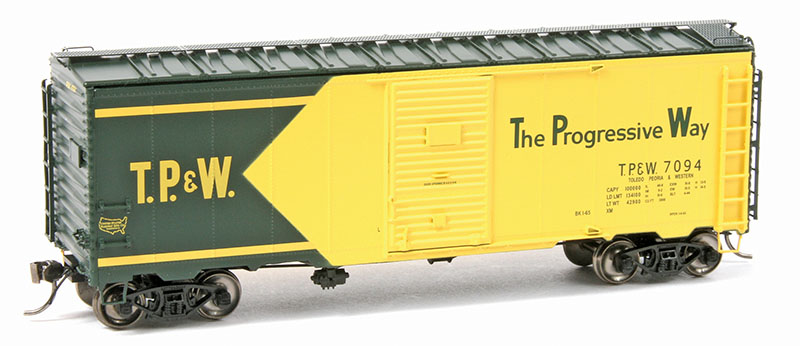
ABOVE: The most colorful boxcars in this release by far are those lettered for Toledo, Peoria & Western with its striking “The Progressive Way” green and yellow paint scheme. Numbered in the road’s 7000 series, TP&W came by its modified 1937 AAR cars secondhand and as rebuilt by United States Railway Mfg. Co. of Washington, Ind., in January 1965. The cars exhibited a new modern diagonal panel roof as well as Morton-style steel running boards. InterMountain has replicated both details with the round-shaped perforations of the Morton patented “Open Grip” running board well replicated in photo-etched fashion on the 1:87 rendering. Besides 7094, TP&W numbers 7009, 7022, 7045, 7056, and 7077 are also available.
InterMountain’s Model
Keeping this quasi-standardization in mind, the job of the model railroad manufacturer to replicate this boxcar accurately is obviously quite a challenge. For InterMountain Railway and its endeavor to recreate the modified 1937 AAR boxcar while still keeping the retail price of these new models in check, variations in tooling were limited, so its development team did its best to pick the most common traits of these cars. It should be noted that, when originally introduced in 1996, this boxcar was offered as a kit only, but starting in the early 2000s, the company took advantage of the more affordable manufacturing process in China and started offering the models as ready-to-run, a trend that continues across the hobby industry currently. The end result is a nicely detailed car that displays the general attributes of this AAR design.
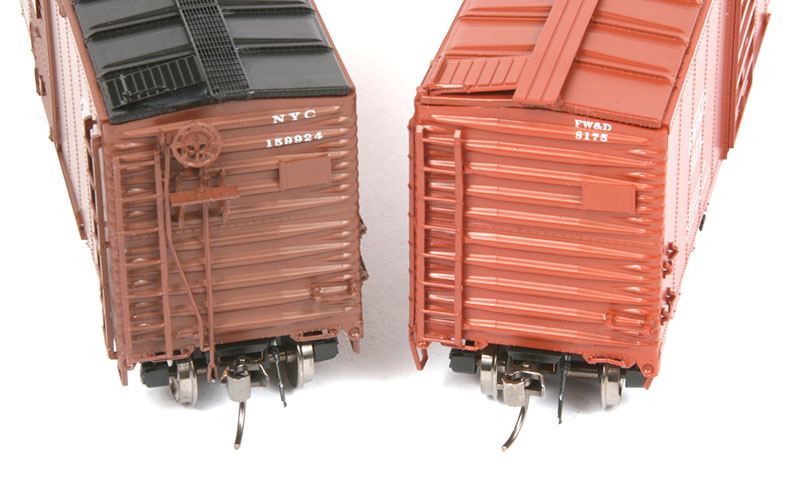
ABOVE: Along with its extended height, the modified 1937 AAR design boxcar featured a new 5/5 Dreadnaught end, which provided an additional rib over the earlier AAR design to stiffen the taller car. Note the B-end of the New York Central car with its Ajax handbrake wheel, add-on bell crank, air line and retainer valve assembly, and brake platform. Meanwhile, both the A- and B-ends on these models share separately applied plastic handholds, tack boards, and either seven- or eight-rung end ladders, as appropriate for the road name. Note also the fine details of the New York Central model’s photo-etched Apex Trilok style running board as compared to the more common injection-molded wood style running board found on the roof of the Fort Worth & Denver sample.
Present are 10-panel riveted sides; separately applied signature 5/5 Dreadnaught ends with fully extended space above the top rib, and thus the 10-foot 6-inch interior height; W-section corner posts; an Ajax-style handbrake; and standard tabbed side sill. Road-specific options are not completely ignored with examples of rectangular- and diagonal-panel roofs evident on our samples; either Youngstown three-panel or Superior seven-panel doors available (non-opening); seven- or eight-rung side/end ladders used; and injection-molded wood-type or photo-etched metal steel-style running boards enhancing the roof.
The major construction details, like panel lines and rivets, are molded-in the proportionally accurate plastic carbody and exhibit sharp relief in a delicate scale-like nature — despite the age of the tooling. Meanwhile, additional add-on parts include: plastic tack boards, corner stirrup steps, and individual handholds; center sill and crossbearers depicted beneath the car; handbrake wheel with bell crank, retainer valve, and air line assembly on the B-end of the car; and AB-style brakes with cylinder, air reservoir, valve, and linkage details, plus all the major plumbing runs through to the air hoses/glad hands on the car ends. In fact, the only prominent feature missing on these cars are the coupler cut levers, which the motivated modeler can easily add via aftermarket parts. The cars ride on Accurail-made plastic Bettendorf friction truck sideframes, which are outfitted with 33-inch diameter blackened metal wheel sets.
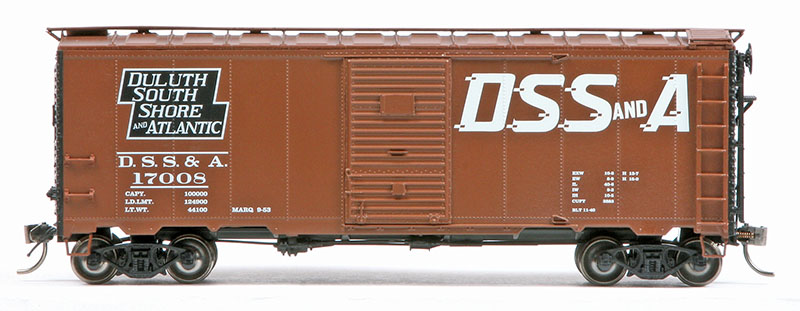
Focusing just on our review samples that represent original owners of the modified 1937 AAR boxcar specifically, I was immediately impressed with all three cars’ flawless body paint, opaque lettering, and laser-sharp graphics. Taking the cars in alphabetical order, InterMountain’s Duluth, South Shore & Atlantic 17008 represents one of 100 cars (numbers 17000–17099) of this type delivered by Pullman-Standard under builder number 5645 in November 1940. As they were erected rather early, this lot of cars exhibited the square corner post and an oddball interior height of 10 feet 5 inches. While the 1:87 model doesn’t replicate the corner post style, it does display the appropriate Youngstown doors, wood-type running boards, and the seven-rung side/end ladders found on the prototype cars. The railroad’s cool lettering scheme and black car ends make this particular model a real standout among the current InterMountain offerings.
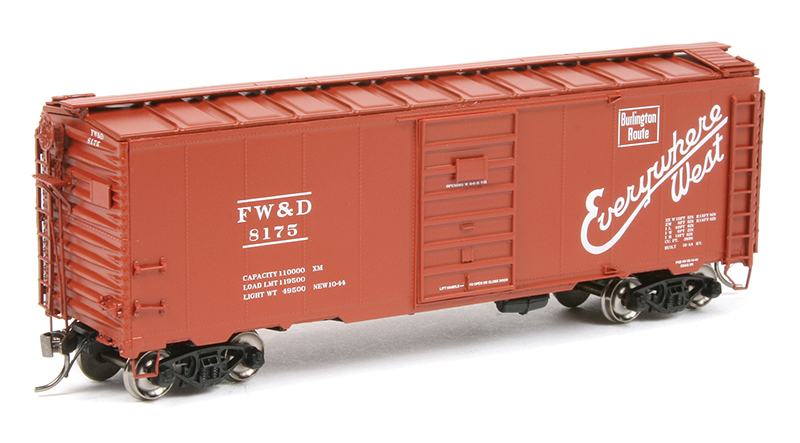
Next up, Fort Worth & Denver (a Chicago, Burlington & Quincy subsidiary) was assigned 500 modified 1937 AAR designed cars, which were built at Burlington’s Havelock Shops in November 1944. Numbered 8001–8500, the car series was constructed with the more common W-section corner posts and full 10-foot 6-inch interior height. The HO-scale Forth Worth & Denver 8175 also provides us with an example of an AAR car equipped with Superior’s seven-panel sliding door. The model correctly displays eight-rung side/end ladders and wood running boards while the lettering scheme properly exhibits “Way of the Zephyrs” slogan on its left side and the famous “Everywhere West” slogan on its right side.
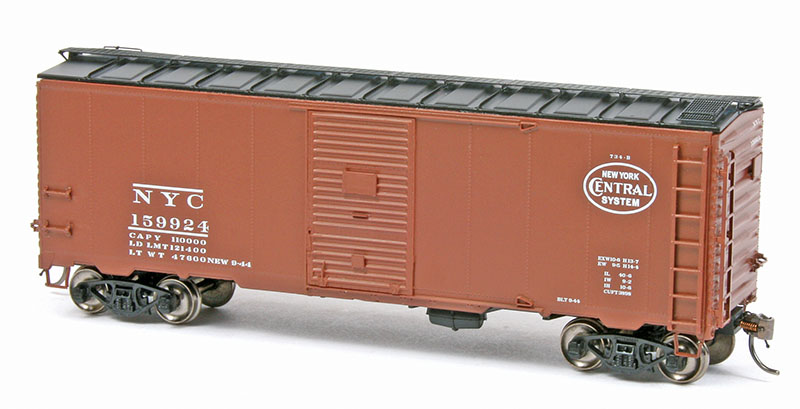
Our New York Central sample represents yet another example of a railroad-built car, this time by the Despatch Shops. New York Central built a total of 2,000 modified 1937 AAR boxcars in two batches, numbers 159000–159999 being delivered in September 1944 and numbers 161000–161999 rolling out in January 1945. Both lots would feature Youngstown doors, W-section corners, and the rather uncommon 10-foot 5-inch interior height. Our HO-scale sample mimics the prototype’s seven-rung side/end ladders and use of steel Apex Trilok running boards, which looks especially nice on the miniature with the rooftop detail being rendered in photo-etched metal, even though the car certainly carries the plainest paint scheme of the bunch.
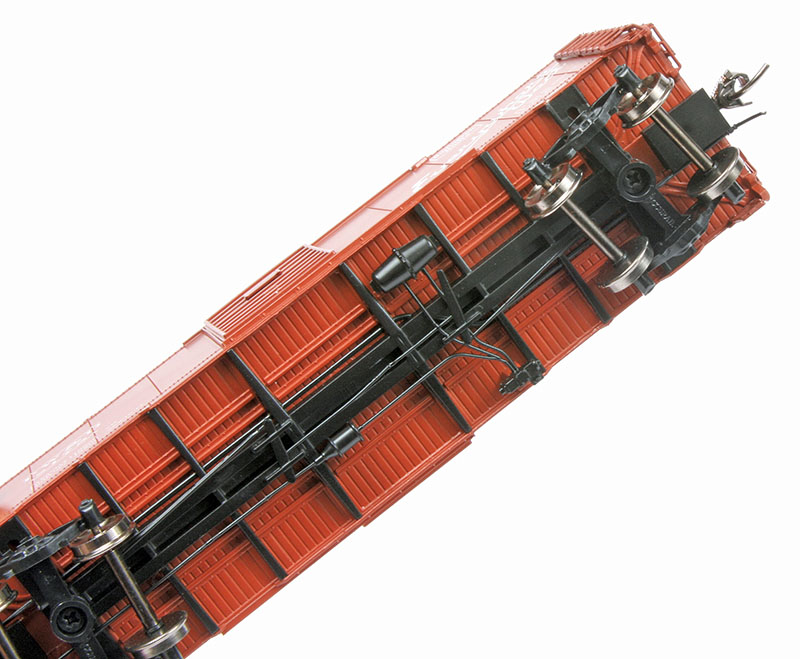
ABOVE: There are plenty of details to enjoy on the underside of InterMountain’s HO-scale boxcar: center sill with crossbearers; AB-style brake gear with add-on reservoir, valve, cylinder, and linkage; all the plumbing runs through to the air hoses located on the car ends; hand applied stirrup steps; and trucks provided by Accurail and equipped with InterMountain’s popular smooth rolling insulated metal wheel sets. While I appreciated the inclusion of metal knuckle couplers, the models are sorely lacking coupler cut levers from their end sills.
Above and beyond simply looking good, though, InterMountain’s rolling stock is designed for the operator. The company’s popular smooth-rolling insulated wheel sets and body-mounted metal knuckle couplers offer these cars excellent performance. Each of our cars was properly weighted (3.6 – 3.7 ounces) per the National Model Railroader Association’s (NMRA) recommended weight based on length calculation, and both wheel gauge and coupler height checked out fine with an NMRA Standards Gage. I put our samples through their paces on my test layout. Easily negotiating 18-inch radius curves and coupled mid-train in a long consist, each car operated admirably, and I experienced no tracking anomalies or failed knuckles.
No Excuses!
InterMountain Railway Co. has definitely captured the spirit of the modified 1937 AAR boxcar with its HO-scale rendering. The release highlights include a number of road-specific variations, accurate recreations of paint schemes, and commendable performance — all at a suggested retail price of $36.95. Considering almost 45,000 examples of this prototype were built, it’s hard to imagine anyone modeling the postwar years through the 1970s not having at least a handful of these boxcars on their layout. There is simply no excuse!
InterMountain Railway Co.
800-472-2530
intermountain-railway.com


